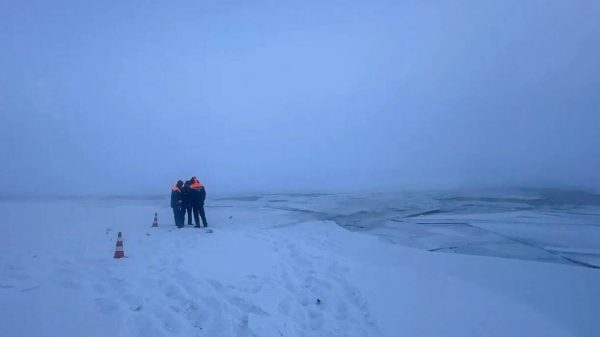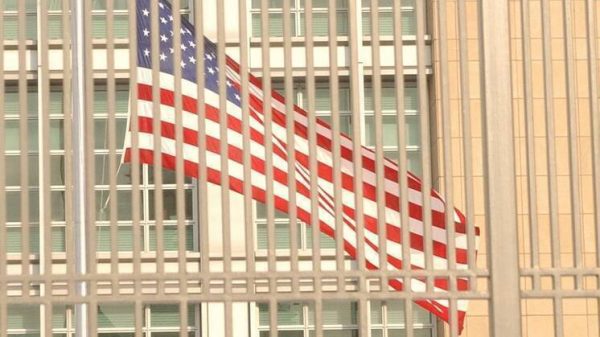Maryann Jacobs’ heart was pounding as she opened her letterbox one snowy morning last year in Hoosick Falls, a small town in upstate New York bordering Vermont and Massachusetts.
Inside was an envelope from the New York state department of health which she knew would reveal the results from a second round of testing for several chemicals that are part of a group of about 5,000 perfluoroalkyl substances, or PFAS (often referred to as “forever chemicals”), in her family’s blood.
‘Forever chemicals’ pollute water from Alaska to Florida
Read more
Inside that envelope was devastating news that her baby son Oliver’s results were worse than she had feared.
The town’s residents had become alarmed in 2015 when a type of PFAS compound called perfluorooctanoic acid, or PFOA, was found in the drinking water. This chemical, which was used by industry for decades to make Teflon coatings and other stain- and water-resistant products, has been linked by scientists to serious diseases.
Because Jacobs became pregnant with Oliver after the PFOA alert, he is the only family member never to drink the town’s water. Neither did Jacobs when she was pregnant or breastfeeding him. She knew some of her chemicals would pass to Oliver in her womb but because the village’s water was being filtered in early 2016, Jacobs thought that he would be mostly protected but to her horror, he was not.
When she got the testing results last winter her own previously high levels of PFOA had plummeted to practically zero but those of baby Oliver, whom she had been breastfeeding for 24 months, had soared to resemble a factory worker’s. His levels –222,000 parts per trillion (ppt) – were 100 times the national average.
By breastfeeding Oliver from 2017 to 2019, Jacobs had unwittingly transferred the chemical to him – a chemical she had come to know was classified as a carcinogen by the International Agency for Research on Cancer. Even low exposures of PFOA had been linked to several types of cancers, many of which had become common in Hoosick Falls.
“The fear, the shock – I try not to carry the guilt, because I didn’t know,” said Jacobs, whose son is now three. “I can’t stop wondering: is this why his teeth are decaying? All his teeth are cracked, and no doctors seem to be able to explain why that is,” she said. “I am afraid it’s because he drank my milk.”
A French multinational, Saint-Gobain Performance, has used PFOA in its manufacturing process at a plastics plant in Hoosick Falls that it has operated since 1999, the Environmental Protection Agency (EPA) has said. The agency has confirmed PFOA contamination in the groundwater at that site, and other locations in the town, and said PFOA can pose “adverse effects to human health and the environment”.
Saint-Gobain and Honeywell International – which previously operated the site – have faced legal actions over the PFOA contamination in the drinking water, including an ongoing class action lawsuit. Saint Gobain said in a statement that it was committed to the “wellbeing of the communities” it operates in, had backed initiatives in the town since the discovery of PFOA including installing water filtration and was working with officials.
Thousands of studies have linked a handful of PFAS to a wide variety of adverse health effects in animals and people. Some of the problems found in humans –including immune system defects, elevated cholesterol levels, liver dysfunction, weight gain, reproductive problems and testicular, thyroid and kidney cancer – have been shown to increase along with the levels of the chemicals in blood.
Women are left with impossible choices
It is estimated that across 49 states, more than 200 million Americans’ drinking water could be contaminated with some level of PFOA or PFOS – two in a family of compounds called PFAS, which have been widely used to make hundreds of products.
In these communities, mothers concerned about potential dangers to their baby’s health have turned to doctors and health departments for guidance about breastfeeding, but six mothers the Guardian spoke to described how they had been told that no matter what, breast is always best, with some states denying them information about what is in their breastmilk by refusing testing.
A growing number of physicians, researchers and studies show that PFOA and PFOS cause short- and long-term health problems in infants, often affecting their weight and their immune system. “The harms of transferring these chemicals in high concentrations could outweigh the benefits of breastfeeding,” said Dr Amalie Timmermann of the University of Southern Denmark. Some experts, like Timmermann, said that women might consider limiting breastfeeding if their levels are high and that, at the very least, they should be given the information that these chemicals are harmful and pass into breastmilk. Most women, however, are unable to make an informed decision, and are left struggling to make impossible choices.
According to Dr Linda Birnbaum, who retired as director of the National Institute of Environmental Health Sciences (NIEHS) in late 2019, the EPA knew there were health problems associated with PFAS since the 1960s. But she said in an interview with the Intercept after she left NIEHS she was not allowed to say that PFAS “caused” certain health effects, despite the scientific evidence. She told the Guardian: “I was called in 2015 by the EPA to tell me they were going to set a lifetime health advisory water limit to 70 ppt, and my response at that time was that it wasn’t a safe enough level, but it was much better than 400 ppt.”
In late 2018, the EPA submitted PFOS and PFOA for internal review; the compounds’ regulatory fate is still being deliberated. To circumvent federal inaction, many states have enacted their own limits on PFAS. Vermont set a standard of 20 ppt in water. New York set 10 ppt. Alaska set none. The Agency for Toxic Substances and Disease Registry (ATSDR) – an agency that has a congressional mandate to review the effects on public health of hazardous substances – was allocated $30m in 2018 to do a large study in at least eight PFAS-contaminated locations. Most of the funding for these studies has been held up by the White House Office of Management and Budget.
But according to Erik D Olson, senior strategic director for health and food at the Natural Resources Defense Council, the Biden administration has promised several specific actions on PFAS. “Instead of making empty promises with no follow-through, Biden will tackle PFAS pollution by designating PFAS as a hazardous substance, setting enforceable limits for PFAS in the Safe Drinking Water Act, prioritizing substitutes through procurement and accelerating toxicity studies and research on PFAS.”
‘Ellie would have been a toxic barrel if I had breastfed’
Emily Marpe had one of the highest levels of PFOA in Hoosick Falls in 2016: 322,000 ppt. So after she delivered her baby Eliana in June 2018 she asked the New York state department of health to test her milk, but this was denied.
Marpe said that her local family physician urged her not to breastfeed – and suggested she pump and dump the milk, which she did. Even so, Marpe decided to test Eliana’s blood when she was seven weeks old: it was 75,900 ppt. “If I had breastfed, I can’t even imagine – Ellie would have been comparable to a toxic barrel by the time she was one,” Marpe said. “It just scares the crap out of me, how can I be fighting so hard to keep it out of our water and then turn around and give it to her through my milk? Breast is best? No, sorry, not in my case.” The state’s response made Marpe angry. “It’s not fair,” she said. “They’re taking away a mother’s right to make a well-informed decision.”
How can I be fighting so hard to keep it out of our water and then turn around and give it to her through my milk?
Emily Marpe
In a statement the New York state department of health said in the past nationwide researchers had not tested for PFAS in breastmilk because “testing PFAS in blood was the most reliable measure”. It said: “Based on the recommendations of ATSDR and CDC, the measurement of PFAS in breastmilk would not have changed our advice that breastmilk is the healthiest source of nutrition and its use should continue because its benefits that outweigh potential risks from PFAS.”
It added that it is participating in a major multi-state PFAS health study with the University of Albany and others, which would include information about breastmilk.
Kelly McLaughlin’s experience in Gustavus, Alaska, was similar to Marpe’s. In July 2018, when McLaughlin was nursing her infant Ruby, she received a letter from the state. It said her local town airport had leaked PFAS chemicals. McLaughlin, who lives several yards away from the airport, immediately asked for more information. She wanted her home drinking water well tested, her blood and her breastmilk. Her requests were denied by the Alaska division of public health.
Desperate for information, McLaughlin paid a commercial lab called Vista Analytical in California to test her blood and breastmilk. One month later she received her results: her blood test indicated traces of several PFAS compounds, including PFOA, and other lesser-known chemicals, while her milk test detected nothing. This troubled McLaughlin. She asked the lab if they noticed any PFAS compounds below their calibration level, which she learned was anything under 50 ppt. They did, and found traces of different PFAS contaminants, which amounted to a level of 81 ppt in her milk.
McLaughlin believes Alaska state health officials need to take the risks of PFAS much more seriously and in her response to the letter rejecting her request for reimbursement of her tests wrote: “It is our right to know, it was not our choice to be a living science project.”
McLaughlin’s experience is no surprise to Pamela Miller, director of the NGO Alaska Community Action on Toxics. Requests by Native women for breastmilk testing have been repeatedly denied since 2005. “I hate to say it, but it’s almost a form of censorship,” Miller said.
Is ‘breast always best’?
Breastfeeding has gone in and out of vogue in the US. In the early 20th century, it was decidedly out but since the late 1970s, breast has been seen as far better than formula. Experts found that breastfeeding helps a child’s immune system develop and that it protects against diabetes, obesity, juvenile arthritis and allergies. The evidence allowed advocates to push back on infant formula companies with marketing strategies promoting often expensive powder’s health benefits.
At the same time that consensus was growing about the benefits of breastmilk, research was showing that pollutants could end up in it. In 1976, the World Health Organization started a global monitoring program to measure certain pollutants in human milk. Dr Walter J Rogan, former senior adviser on environmental toxics and child development at the NIEHS, was one of the first to find that contaminated milk could pose a danger. In 1996, Rogan concluded that environmental pollutants are almost impossible to avoid. Today, most women’s milk contains traces of things like pesticides, flame retardants, or rocket fuel. Rogan also concluded that the benefits of breastfeeding appear to outweigh the risks.
By the late 2000s, most researchers and health departments agreed: in the vast majority of cases, mothers are not at risk for high levels of toxic contaminants in their milk. But despite the consensus, some researchers remained troubled. “You’ll find that this is quite a touchy subject for many folks,” wrote Dr Gina Solomon, a clinical professor of medicine at the University of California San Francisco in an email: “This was a big issue 20 years ago, but the research on this has largely died out in the US.”
The Guardian interviewed more than 20 scientists for this article, including three who asked to speak anonymously, who have called this issue “difficult”, “complex”, “emotionally fraught” and “taboo”. Most of them said they do not want to scare women away from breastfeeding. “It is a tough balance,” Solomon wrote, “since the benefits of breastfeeding are quite well-established and the risks of many of the contaminants are a bit less clear.” There is also the problem that, oftentimes, mothers have few alternative solutions and formula may also be contaminated if mixed with non-filtered water.
Breastfeeding advocacy groups argue that chemical or environmental risks should not sway a mother’s decision. For instance, one La Leche League webpage says: “Concerned About Environmental Contaminants? Your Milk Is Still Best for Your Baby.”
In emailed responses to requests for comments, Alison Linnecar of the International Baby Food Action Network (IBFAN), said that breastmilk is often portrayed as an inferior women’s product compared with the “superior hi-tech manmade product, formula”. Dr Adriano Cattaneo of the International Society of Doctors for Environment added that except for “very emergency situations”, breastfeeding should be promoted.
Why dangerous ‘forever chemicals’ are allowed in US drinking water
Read more
Tobyn McNaughton, of Grand Rapids, Michigan, said it was a struggle to decide whether her situation was an emergency. McNaughton lives around a half-mile from a dump that, the EPA said, needed cleanup after groundwater contamination in 2017 linked to a former tannery run by the Wolverine Worldwide shoe company, including forever chemicals. In December that year, McNaughton was devastated to learn that her 20-month-old son, Jack, had PFOS blood levels of 484,000 ppt. “He had twice as much PFAS as I do, and part of that came from the water, and in utero, but I also breastfed him for 14 months, pretty much exclusively,” McNaughton said. She believes that Jack’s high levels of PFOS have weakened his immune system: he is often sick and some of his vaccines have been ineffective.
Last winter, McNaughton was expecting her second child and said she didn’t know whether to breastfeed. She said she was torn about her decision until the moment Bruce was born in January. “It was still on my mind while I had a C-section: am I going to feed him as soon as he comes out?” In the end, she decided to breastfeed. But her questions never stopped: “Am I going to regret it?”
Shorter periods of breastfeeding
Dr Philippe Grandjean, a leading environmental health expert and professor at Harvard University has researched breastmilk contaminated with PFAS. In one study, he tested responses to vaccines by looking at levels of several types of PFAS in infants’ blood at birth and ages 11 months, 18 months and five years in the Faroe Islands. He found that the higher the exposure to PFAS, the more likely that tetanus and diphtheria vaccines were not effective.
The IBFAN criticized one of Grandjean’s Faroe Islands studies, writing in a letter to the journal editor that it “gave rise to sensationalist articles”.
But Grandjean insists added exposure to PFAS through breastmilk can lead to a much higher level of the chemical in the infant compared with exposure in utero, causing additional risk during sensitive early development. Pointing to his research, Grandjean said: “After birth, breastfeeding can add 10 times as much as prenatal exposure. And so, one could then discuss: isn’t the prenatal period more vulnerable in regard to developing organ systems? And that’s possible, but there are certain organs like the brain and the immune system that continue a very sophisticated and complex development after birth.”
Grandjean said that mothers with high body concentrations of PFAS should consider breastfeeding for shorter periods, such as “three to four months because the infant would then gain most of the natural benefits”, he said. “We think that the buildup of contaminants in the infant’s body is interfering with the child’s immune system and other development.”
The experience of women in America is contrary to countries like Germany, where the government has tested women’s breastmilk for decades. In several German states, it is a woman’s right to get her breastmilk tested for contaminants free of charge.
Dr Stephanie Canale three years ago created the Lactation Lab, based in California, and for between $99 and $349, the lab will test breastmilk samples. According to Canale, PFAS chemicals are third on the list of most-wanted chemicals for testing, after glycerin and platinum. Canale said she had not been able to convince insurers to cover the cost.
“We need to talk about this stuff, and stop pretending that everything is just magical and perfect,” Canale said, “I am tired of this view that if women have information, then they’re not going to deal with it, that we need to protect them, and that they’re not grown enough to make their own decisions.”
•••
In Hoosick Falls, Maryann Jacobs is scared for her youngest, Oliver, her daughters, her husband and herself as well. Last winter, she discovered a lump in her left breast. A mammogram didn’t bring any answers and her doctor, unsure about the results, has advised her to get more tests. This lack of certainty also goes for Oliver, whose teeth problems are a mystery to doctors.
Jacobs is keeping a close watch on her baby boy’s wellbeing – unclear how the large quantity of the toxic chemical in his small body may affect his development in the future. “We are a part of the learning process of what this chemical can do and how it can be broken down and how long it takes to leave the body,” she said. “It’s like we’re part of a study.”






















































Свежие комментарии